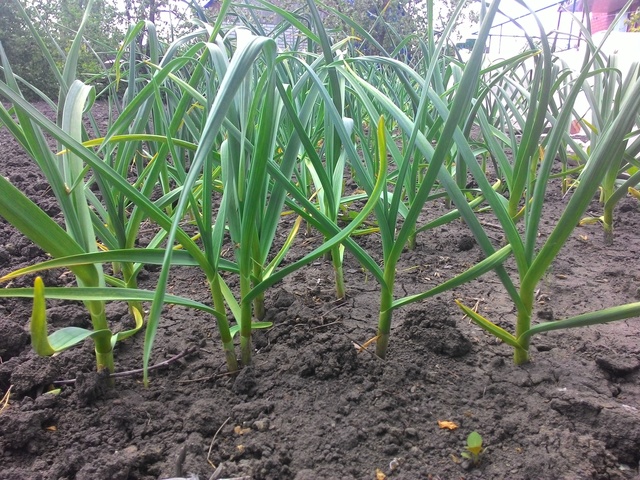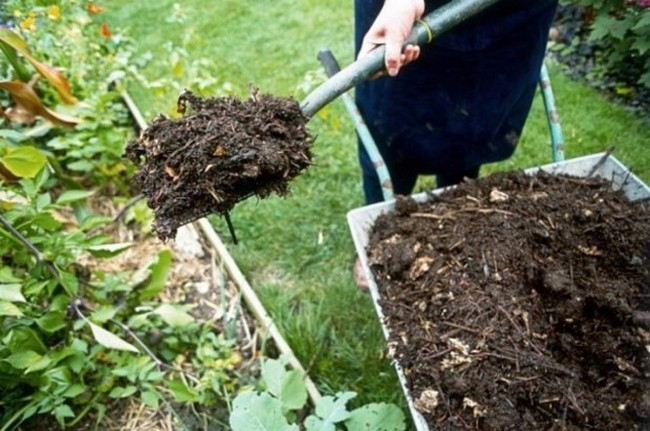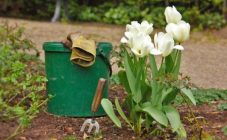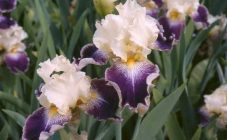Content:
When garlic rises in the spring, immediately after the snow melts, it needs to be provided with immediate proper care. At this time of year, grooming is very important, because it is when the garlic sprouts that everything necessary for a good harvest in the future is laid.
The uniqueness of garlic, whose homeland is located in the far east, lies in the fact that it can survive and grow even at negative air temperatures, and in the presence of a very small plus, it already forms cloves.
Spring care rules
When the garlic rose in spring, perform the following operations:
- Loosening is performed between the plants of garlic, as well as between the rows, and regularly;
- Water as needed;
- They are fed at the appointed time;
- Weeds are weeding.
When all of the above points are completed, the gardener has the right to count on a good harvest.
When to open garlic beds after winter? The first step is to remove the shelter from the beds, which protected the winter garlic plants from winter frosts, so that it can germinate better. It is better to do this in the morning, so that the mud at the landing site freezes a little.
After that, it is necessary to fulfill one more prerequisite after germination, namely, close the moisture in the garlic bed. This procedure does not tolerate delay, since in spring the earth has the property of drying very quickly, and a crust forms on the ground, and then cracks.
When the next spring rain passes, they start loosening. If there is no rain, then this is done after each irrigation performed.
How to water properly
Garlic does not die if it lacks moisture, but this significantly affects germination and yield. Regular watering is necessary, especially with a dry spring and when seedlings are just emerging and at later stages. The preferred irrigation scheme may be as follows:
- In cloudy weather, you do not need to water;
- In moderate heat, if it rains sometimes, water it every week;
- In case of severe spring drought, watered every 4 days.
Top dressing
The necessary fertilizers provide the winter garlic with normal growth when it has already sprouted, and proper head formation afterwards. Fertilizers are used in different periods. A high yield is achieved if the garlic is well fed.
It is better to feed garlic in stages, the first of which is needed for pasture of the stalks. In this case, a urea solution is used.
The second stage, necessary for the formation of teeth, is carried out after 2 weeks using nitrophoska and nitroammophoska.
The third stage helps the already slightly formed heads grow. Superphosphates and potassium are used. Garlic is also sprinkled with wood ash.
When Garlic Is Opened
When winter garlic plants are planted at their summer cottage in the fall, they resort to careful warming so that it does not freeze during the winter. Leaves, peat or hay are used to shelter garlic. With the help of such insulation, the plant is able to withstand rather low temperatures. When to open garlic after winter?
Garlic opening times
When spring comes, it is important not to rush to open the garlic beds.It is necessary to wait for the time when the cold weather will completely go away, during this period you can see green shoots through the insulation. The covering material is removed after the snow has completely melted, and the average temperature per day will not be lower than -6 degrees. And even if the sprouts have not yet sprouted, and there is no more snow, you can safely open the beds, since the time has come when the plantings of winter garlic are opened.
Since each region has its own distinctive climatic conditions, it is not possible to accurately determine a single time for opening garlic beds. In Primorye or in the Far East, for example, in Khabarovsk, the time to complete this procedure will differ from the same in the middle zone or Siberia. If you plant garlic correctly, subject to all the necessary rules, with a favorable soil composition, it winters very well and if you remove the covering material a little earlier, nothing bad will happen.
Garlic opening instruction
- Covering material is removed;
- A little loosening is done to break up the top crust of the earth.
Mulching garlic in spring
The technique in agriculture, which is called mulching, is that the culture in the garden is covered with a layer of materials of organic and inorganic origin. This process significantly increases yields. But in mulching, as in other agricultural practices, there are pros and cons. Why mulching is worth using:
- It becomes more difficult for weeds to climb through the layer of mulch, so the beds need to be weeded less often when the garlic sprouts;
- Garlic is a very moisture-loving plant, so watering is carried out up to 5 times a week. Mulched beds retain moisture longer as it evaporates much more slowly. For summer residents who only go to the site for the weekend, this procedure provides a lot of amenities;
- With mulching, you don't have to worry about unexpected spring frosts. In addition, the harvest will be a little earlier than usual;
- It is recommended to loosen the garlic for oxygen access. After covering the mulch, loosening is minimized;
- Protected from the aggressiveness of the sun, the earth is more humid, which contributes to more active reproduction of the necessary bacteria and the soil becomes more fertile.
Disadvantages:
- In the summer, when it often rains, mulching is not recommended due to the possible formation of fungus;
- The right types of mulch must be carefully selected; certain types of mulch may not be suitable for some crops.
Mulch types
- Compost, which contains microorganisms, improves the soil structure. It gives the crop protection against diseases and prevents the formation of a large number of weeds;
- For crops that form bulbs, foliage has recently been used;
- Straw is a widespread material for mulching. It takes a long time to decompose and therefore is good for garlic in the spring;
- Peat is mainly used for raspberries or tomatoes as it increases the looseness of the soil. Fine and dry, it is also used for garlic;
- The available mulch that is easy to find is sawdust.
But is it possible to mulch garlic with sawdust? Sawdust, which includes microorganisms that feed on nitrogen, give the right to exist to the opinion that mulching with them is not worth it, due to the lack of this nitrogen in the culture and that the leaves of the garlic turn yellow from this.
But, as practice shows, if the sawdust is covered with earth quite a bit, the organisms no longer use nitrogen. When mulching garlic with sawdust, the plant feels much better than under other types of mulch, as a result of which black soil builds up. When asked whether it is possible to mulch onions with sawdust, the unequivocal answer, of course, is yes. It is possible and necessary to mulch onions with sawdust.
Mulching rules
The best time for mulching is the very end of May or the beginning of June. During this period, fungi are not too active. Mulch creates a comfortable temperature regime at the roots of the culture, preventing the earth from overheating and drying out.
You should not mulch even in light rain, it is better to wait until it ends. First, the bed is loosened, and then mulch with a layer of 5-7 cm.
Organic mulch can stay in the winter. This is useful for creating humus.
To get a good harvest of garlic in the form of large and juicy bulbs, you must carefully and competently care for it. Subject to all not too complicated recommendations, even a beginner in the gardening business is able to get tasty and healthy garlic in sufficient quantities to his table.















